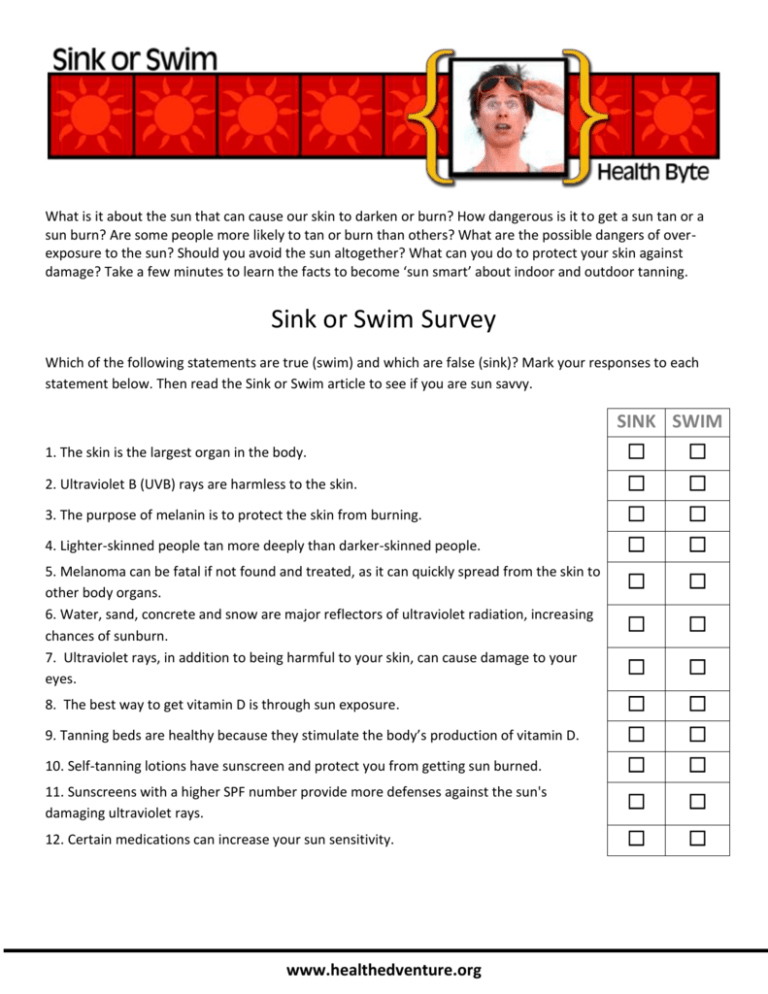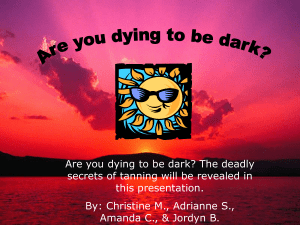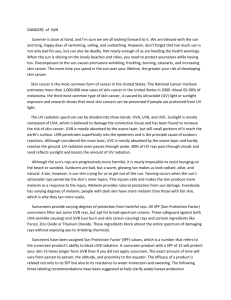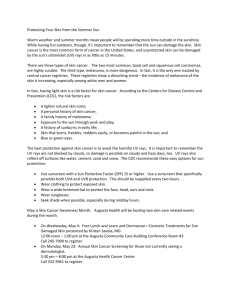Sink or Swim
advertisement

What is it about the sun that can cause our skin to darken or burn? How dangerous is it to get a sun tan or a sun burn? Are some people more likely to tan or burn than others? What are the possible dangers of overexposure to the sun? Should you avoid the sun altogether? What can you do to protect your skin against damage? Take a few minutes to learn the facts to become ‘sun smart’ about indoor and outdoor tanning. Sink or Swim Survey Which of the following statements are true (swim) and which are false (sink)? Mark your responses to each statement below. Then read the Sink or Swim article to see if you are sun savvy. SINK SWIM 1. The skin is the largest organ in the body. ☐ ☐ 2. Ultraviolet B (UVB) rays are harmless to the skin. ☐ ☐ 3. The purpose of melanin is to protect the skin from burning. ☐ ☐ 4. Lighter-skinned people tan more deeply than darker-skinned people. ☐ ☐ 5. Melanoma can be fatal if not found and treated, as it can quickly spread from the skin to other body organs. 6. Water, sand, concrete and snow are major reflectors of ultraviolet radiation, increasing chances of sunburn. 7. Ultraviolet rays, in addition to being harmful to your skin, can cause damage to your eyes. ☐ ☐ ☐ ☐ ☐ ☐ 8. The best way to get vitamin D is through sun exposure. ☐ ☐ 9. Tanning beds are healthy because they stimulate the body’s production of vitamin D. ☐ ☐ 10. Self-tanning lotions have sunscreen and protect you from getting sun burned. ☐ ☐ 11. Sunscreens with a higher SPF number provide more defenses against the sun's damaging ultraviolet rays. ☐ ☐ 12. Certain medications can increase your sun sensitivity. ☐ ☐ www.healthedventure.org 1. The skin is the largest organ in the body. Swim (TRUE) The cells of the human body are grouped into organ systems serving essential functions. As the largest organ in your body, the skins purpose is to act as a barrier to protect all other organs, bones, muscles and blood vessels from harm. The skin is made up of two layers. The outside layer, known as the epidermis, shields the inside layer, known as the dermis. The dermis contains nerve endings, sweat glands, hair follicles and blood vessels. 2. Ultraviolet B (UVB) rays are harmless to the skin. Sink (FALSE) Ultraviolet light is the form of sunlight that can damage the skin and eyes. Ultraviolet light (UV) comes in three types: • • • UVA rays – The UVA rays cause premature aging of the skin as well as skin cancer. These are also the rays that cause tanning of the skin. UVB rays – The UVB rays cause damage in the form of sunburn, wrinkles and skin cancer. UVC rays – The UVC rays are the most dangerous form of UV light. Fortunately these rays are filtered out by the atmosphere and never reach the earth. 3. The purpose of melanin is to protect the skin from burning. Swim (TRUE) Your skin contains a chemical called melanin. Melanin, which is produced by cells called melanocytes, is the pigment that gives skin, hair and eyes their color. UVA radiation penetrates through the lower layers of the epidermis prompting the melanocytes to produce melanin, causing your skin to tan. Melanin’s purpose is to protect the skin from burning. By consuming the UV radiation and darkening the skin, melanin can shield the new cells forming in the deeper layers of the skin. www.healthedventure.org 4. Lighter-skinned people tan more deeply than darker-skinned people. Sink (FALSE) Darker-skinned people have more melanin than lighter-skinned people, which causes darker-skinned people to tan more deeply. The amount of melanin also protects a darker-skinned person from sunburn longer than a lighter-skinned person. However, just because a person doesn't burn does not mean that he or she is also protected against skin cancer and other problems. 5. Melanoma can be fatal if not found and treated, as it can quickly spread from the skin to other body organs. Swim (TRUE) The UVA rays that cause the skin to tan, can pass through the skin's protective epidermis to the inside layer called the dermis. The dermis is the layer where blood vessels and nerves are found. By reaching this layer and everything that it contains, the UVA rays may suppress a person's immune system which will make it harder to fight off diseases. This can also lead to melanoma, the most serious type of skin cancer. Melanoma is fast growing and can be fatal if not found and treated. 6. Water, sand, concrete and snow are major reflectors of ultraviolet radiation, increasing chances of sunburn. Swim (TRUE) UVB rays cause the skin to turn red and sunburn. Exposure to UVB rays damages the skin’s epidermal layers and also increases the risk of getting two other types of skin cancer: basal and squamous cell carcinoma. The intensity of these rays varies by season, location and time of day. The rays are strongest between 10 a.m. and 4 p.m. between the months of April to October. UVB rays can burn and damage your skin year-round, especially at high altitudes and when reflected off of surfaces such as water, snow, sand or concrete. 7. Ultraviolet rays, in addition to being harmful to your skin, can cause damage to your eyes. Swim (TRUE) UV rays can also lead to cataracts and other eye damage. Cataracts cloud the vision and if left untreated can lead to blindness. Although cataracts are curable with modern eye surgery, they affect the eyesight of millions of Americans and cost billions in medical care. www.healthedventure.org 8. The best way to get vitamin D is through sun exposure. Sink (FALSE) Vitamin D is an essential nutrient good for overall health and strong bones. The body is designed to make its own vitamin D when skin is exposed to the UVB rays in sunlight. For most people, 5-10 minutes of unprotected sun 2-3 times a week is enough to help your skin make the vitamin D it needs. However, factors such as the time of day, how close you live to the equator, the color of your skin and the amount of skin that is exposed affect how much vitamin D is produced in your body by sun exposure. Taking a vitamin D supplement is an effective way to get the vitamin D your body needs. 9. Tanning beds are healthy because they stimulate the body’s production of vitamin D. Sink (FALSE) Even though vitamin D is necessary for good health, it is not necessary to tan your skin to get the vitamin D you need. You can make vitamin D by using a tanning booth, however rays from tanning beds are up to 15 times stronger than the UV radiation from the sun. Tanning booths emit mostly UVA rays. These are not the UV light needed to create vitamin D and the UVA rays can penetrate to the dermis which can cause abnormal cells to grow and develop into melanoma. While tanning booths also emit some UVB, the time spent in a tanning booth can increase your chances of getting melanomas as well as other types of skin cancer (basal cells and squamous cells). 10. Self-tanning lotions have sunscreen and protect you from getting sun burned. Sink (FALSE) Many products on the market will let you tan safely and sun-free. However, if you use a sunless tanner, you still need to wear plenty of sunscreen when going outdoors. Self-tanners don't stimulate the melanin production process the way the sun does, so the tan they create won't protect you against sunburn. www.healthedventure.org 11. Sunscreens with a higher SPF number provide more defenses against the sun's damaging ultraviolet rays. Swim (TRUE) When purchasing sunscreen, look at the Sun Protection Factor (SPF) Level. The SPF is a measure of a sunscreen's ability to prevent UV rays from damaging the skin. For example, if it takes 20 minutes for your unprotected skin to start turning red, using an SPF 15 sunscreen prevents your skin from reddening 15 times longer, about five hours (20 minutes times 15 = 300 minutes). Is it recommended that you use a broadspectrum sunscreen (meaning that it blocks both UVA and UVB rays) with an SPF of at least 15 every day, even on cloudy days. 12. Certain medications can increase your sun sensitivity. Swim (TRUE) Because skin cancer is at an epidemic level in the United States, with more than one million new cases diagnosed every year, it is important to know everything you can to protect yourself. Many medications, such as antibiotics used to treat acne and birth control pills, can increase your sun sensitivity. Be sure to read and heed any information that comes with medications and take the necessary precautions. It only takes one blistering sunburn in childhood to double a person's chances of developing skin cancer later in life. Teens need to be especially cautious as they may be more susceptible to skin cancer because their cells are dividing and changing more rapidly than those of adults. www.healthedventure.org






